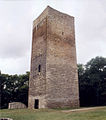Lower Sachsenburg
| Lower Sachsenburg | ||
|---|---|---|
|
The castle seen from the spot (2005) |
||
| Alternative name (s): | Lower castle, Hakenburg | |
| Creation time : | 1100 to 1200 | |
| Castle type : | Hilltop castle | |
| Conservation status: | Keep, remains of the wall | |
| Standing position : | Nobles, counts | |
| Place: | Sachsenburg | |
| Geographical location | 51 ° 17 '36.5 " N , 11 ° 9' 55" E | |
| Height: | 190 m above sea level NN | |
|
|
||
The Lower Sachsenburg , also called Unterburg or Hakenburg , is the ruin of a hilltop castle near Sachsenburg , a district of the municipality of An der Schmücke in the Kyffhäuserkreis in Thuringia .
The keep , parts of the curtain wall and cellar are still preserved from the medieval castle . The complex has been owned by the Thuringian Palaces and Gardens Foundation since 2002 .
Geographical location
The ruins of Untere Sachsenburg are located north of the town of the same name on the top of the extreme east-south-east foothills of the Hainleite ridge . Surrounded by forest a little above the Thuringian Gate , through which the Unstrut flows , it is located about 450 m southeast of the Upper Sachsenburg .
history
The castle is the older of the two Saxon castles. The time when the castle was built has not been conclusively clarified. There is no evidence whatsoever for an edification by a knight von Hake around 940 that is occasionally mentioned in the literature. However, the Thuringian Hagke, as ministerials, administered the rule for their owners until the 13th century . The Counts of Orlamünde , who owned the rule until the middle of the 11th century, or the Landgraves of Thuringia , who had owned the rule since 1180 at the latest, could be considered as builders of the castle . The castle's task was to secure access to the central Thuringian basin .
After the death of the last Ludowingian Landgrave Heinrich Raspe in 1247, Count Siegfried von Anhalt (r. 1252–1298) occupied the Palatinate County of Saxony . He must also have taken the castle. He had the Upper Sachsenburg built for reinforcement.
From the following arguments with the Margraves of Meissen , they emerged victorious. It is doubtful whether the “Saxinberg” castle actually razed in the Weissenfels Treaty of 1249 actually took place. The castle must have existed in 1287 because it was successfully defended against Adolf von Nassau .
When Dietrich von Hohnstein married Sophia von Anhalt, the castle came to the Counts of Hohnstein in 1316.
In 1319 a distinction was first made between the upper and lower castle. After a feud, the Counts of Hohnstein had to recognize the feudal sovereignty of Landgrave Friedrich I (1292-1323).
The castle came to the Counts of Beichlingen from 1335 to 1407 by marriage . From 1407 the castle was owned by the Landgraves of Thuringia and Dukes of Saxony. From this point on, it served as the seat of the Sachsenburg office .
With the relocation of the official seat to the town in 1815, the complex lost its importance and was given up.
Remains of the curtain wall and a vault (2005)
Keep (2005)
literature
- Michael Köhler : Thuringian castles and fortified prehistoric and early historical living spaces . Jenzig-Verlag Köhler, Jena 2001, ISBN 3-910141-43-9 , p. 125: Hakenburg .
- Thomas Bienert: Medieval castles in Thuringia. 430 castles, castle ruins and fortifications . Wartberg-Verlag, Gudensberg-Gleichen 2000, ISBN 3-86134-631-1 , p. 156–158: Ruins of the lower and upper Sachsenburg .
- Berent Schwineköper (Hrsg.): Handbook of the historical sites of Germany . Volume 11: Province of Saxony Anhalt (= Kröner's pocket edition . Volume 314). 2nd, revised and expanded edition. Kröner, Stuttgart 1987, ISBN 3-520-31402-9 .
Web links
- Thuringian Palaces and Gardens Foundation - Sachsenburgen
- Information about the Saxon castles
- Reconstruction drawing
Individual evidence
- ↑ Map services ( memento of December 19, 2012 in the Internet Archive ) of the BfN
- ^ Castle archive: Thuringian Hagke



